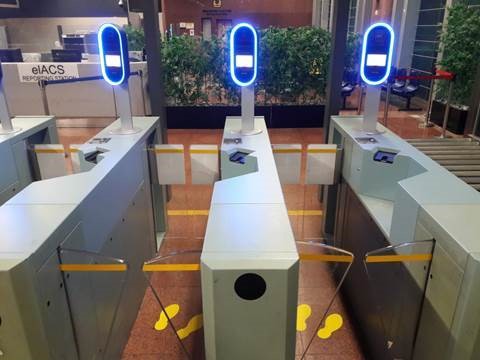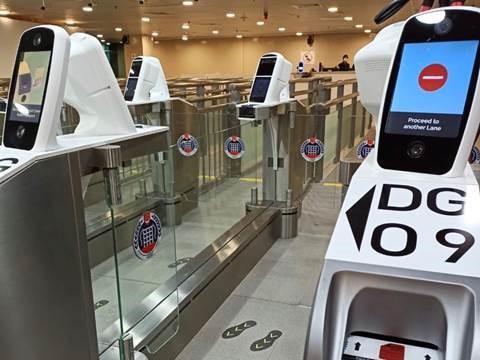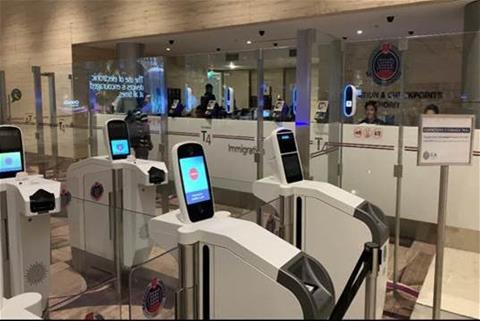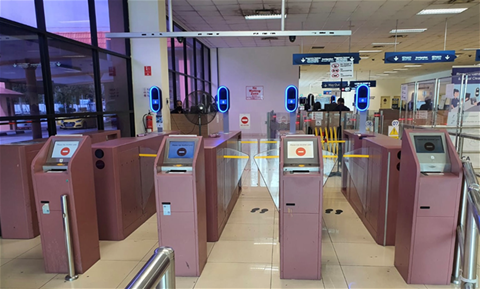Use Of Iris And Facial Biometrics As The Primary Biometric Identifiers For Immigration Clearance At All Checkpoints
The Immigration & Checkpoints Authority (ICA) has been progressively implementing more secure and efficient immigration clearance, in collaboration with the Home Team Science and Technology Agency (HTX). Since July 2020, all automated and manual immigration lanes and counters at the passenger halls of Singapore’s land, sea and air checkpoints have been equipped with iris and facial scanners (see Annex A for photos). Iris patterns and facial features will replace fingerprints as the primary biometric identifiers for immigration clearance. Fingerprints will be used as a secondary biometric identifier for travellers who are unsuccessful in their iris and facial scans.
Secure and Efficient Immigration Clearance
2. Since ICA implemented the enhanced-Immigration Automated Clearance System (eIACS) in 2006, fingerprints have been the primary biometric identifier for immigration clearance at our checkpoints. ICA started enrolling the iris images of Singapore Citizens and Permanent Residents from 1 January 2017, as iris patterns have a number of strengths as a biometric identifier compared to fingerprints.
3. By using iris patterns in lieu of fingerprints for identification, issues with fingerprint verification, such as deterioration of fingerprints due to ageing, scarring or dryness, are avoided. This will enable travellers who currently have difficulty authenticating their identity using fingerprints to use the automated immigration clearance lanes. Second, iris patterns have a higher degree of variation and uniqueness than fingerprints, and are therefore more robust and reliable for use for identification purposes. An iris scan provides almost 250 feature points for matching, as compared to about 100 feature points for a fingerprint. In addition, specialised equipment is required to conduct the iris scan, which makes it less susceptible to misuse.
4. To further strengthen the identification process, we will employ iris and facial scans concurrently. Facial recognition provides a second check of a person’s identity. The use of two biometric identifiers (i.e. iris patterns and facial features) will provide even more reliable authentication of the identity of travellers, and further strengthen ICA’s ability to safeguard Singapore’s borders. For travellers, the new immigration system allows for simultaneous and touch-free capture of these two biometrics, and offers more hygienic, more convenient and more efficient immigration clearance.
Who Can Use Iris and Facial Scans
5. Singapore Citizens, Permanent Residents, long-term pass holders, as well as international travellers on our Frequent Traveller Programme (FTP) who have enrolled their iris and facial biometrics with ICA, are eligible for this new mode of clearance (see Annex B for the detailed list of eligible travellers).
6. When these travellers approach the automated immigration lanes, they will be prompted to use their iris and facial biometrics for immigration clearance. If authentication via iris and facial biometrics is unsuccessful or if they have yet to enrol their iris and facial biometrics with ICA, such travellers will be prompted to clear immigration using their fingerprints.
7. Singapore Citizens, Permanent Residents and long-term pass holders who have yet to enrol their iris and facial biometrics with ICA and are keen to do so can seek the assistance of ICA officers at the checkpoints when they travel or when they visit the ICA Building for immigration facilities (e.g. renewal of passport or re-registration of identity cards).
8. Children who are below six years of age will not be eligible to use iris and facial scans for clearance. This is because their physical features and related biometrics are still developing and thus may not provide a reliable means of authentication. They will be enrolled at a later age.
9. First-time foreign visitors to Singapore will need to enrol their iris, facial and fingerprint biometrics on arrival at the manual immigration counters. They will be able to use automated clearance when they depart Singapore. For their subsequent trips to Singapore, they can clear immigration using their iris and facial biometrics at the manual counters, if they are using the same passport as when their biometrics were enrolled.
Advisory to Travellers
10. With the implementation of iris and facial scans at our checkpoints, travellers are advised not to wear sunglasses, caps, or other head gear that obstruct their iris and facial images when clearing immigration. They are also advised not to wear coloured or patterned contact lenses. Face masks must be removed during immigration clearance.
Transforming Immigration Clearance – Faster and More Secure
11. The use of iris and facial scans is part of our plan to transform Singapore’s checkpoints, to provide travellers with more secure and efficient immigration clearance. We aim to realise our New Clearance Concept (NCC) at our checkpoints by 2022.
12. Beyond multi-modal biometric clearance, the NCC will eventually enable Singapore residents to clear immigration at our checkpoints without the need to present a passport. We also aim to enable the majority of foreign visitors, including first-time visitors, to clear immigration at the automated lanes on arrival, without the need for prior enrolment of their biometrics. More details on these developments will be provided at a later date.
IMMIGRATION & CHECKPOINTS AUTHORITY
HOME TEAM SCIENCE & TECHNOLOGY AGENCY
28 OCTOBER 2020
ANNEX A – Automated immigration lanes with iris and facial scanning at land, air and sea checkpoints

Tuas Checkpoint

Woodlands Checkpoint

Changi Airport Terminal 4

Tanah Merah Ferry Terminal
ANNEX B – Travellers who are eligible to use iris and facial scans for arrival and departure immigration clearance
- Singapore citizens who hold a K-series passport or have enrolled their iris and facial biometrics with ICA when they registered or re-registered for an Identity Card (IC) from 2017.
- Permanent residents who have enrolled their iris and facial biometrics with ICA when they registered or re-registered for an IC from 2017.
- Long-term pass holders (e.g. Student’s Pass holders) who have enrolled their iris and facial biometrics in past transactions with ICA from 2019.
- International travellers who have enrolled in the Frequent Traveller Programme using iris and facial biometrics.
- [Only for departure clearance for that trip] International travellers who are not in the Frequent Traveller Programme but have enrolled all three biometrics (fingerprint, iris and facial) at the manual counter upon their arrival in Singapore.
Note: Children who are below six years of age will not be eligible to use iris and facial scans for clearance.

